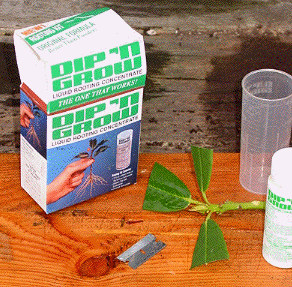

Rhododendrons are more difficult to root that many other garden plants, but by following these guidelines, you should be successful. Some rhododendrons are easier than others, so all of these suggestions are not necessary all of the time. Sometimes circumstances make following them impossible.
All of the cuttings in the Anderson Garden have been propagated in Nearing Frames. Another method is to use a greenhouse. The advantages we have found to the Nearing Frame are minimal expense to build and operate, limited air volume to reduce problems with fungal growth, and minimal space requirements. My father and I have used Nearing Frames in three locations for more than fifty years.
SELECTING THE CUTTINGS
A cutting is the end of a stem, usually about three inches long. Cuttings can be taken with sharp clippers or a knife, and recut with a razor blade just before setting.
* Timing is more important than any of the other guidelines. Wait until the new growth has begun to harden up, but has not reached full stiffness for winter. For most rhododendrons (except for tiny leafed dwarfs and deciduous azaleas ) I take cuttings in September and October. It is better to err late than early.
* If possible, take cuttings in the morning while the leaves have their maximum moisture content.
* Choose cuttings on the north side of the plant, or a part that is shaded.
* Take cuttings after or during a rain, or water the plant the evening before.
* Don't take the most or the least vigorous shoots.
* Don't take cuttings from the top of the plant.
* Take cuttings as close to setting time as possible.
* Collect cuttings in a plastic bag containing a little water.
* Choose healthy plants for cutting stock.
* If possible, take only stems with leaf buds. If you have to take a cutting with a flower bud, don't remove it right away. The injury will expose the cutting to fungal growth. Rather, let it wither and then take the dead bud away later.
PREPARING THE CUTTINGS (See above picture.)
* Trim the cutting down to about three leaves. If the surface is still too large, slice off part of each leaf. The object is to minimize transpiration, since the moisture intake ability has been drastically reduced. Still, some leaf surface is necessary for root growth.
* Recut the stem on a diagonal with a razor blade or other clean, sharp instrument. The diagonal maximizes water intake through the stem.
* Make a cut or slice wound on the stem. This stimulates the plant to send rooting hormones to the area. Dennis Bottemiller, propagator for the Rhododendron Species Foundation, says a small cut is preferable, since it exposes less raw material to the fungi. The wound is not necessarily where the roots form anyway.
* Dip the cutting in a rooting hormone, such as Dip 'n Grow. I treat about six at a time. Most hormones available at garden centers are not strong enough for hardwood cuttings, so you might have to go to a nursery supply source.
* Insert the cuttings into the medium, spaced so that leaves do not touch each other. If you do not use pots, a board with spaced nails makes an even row of holes.
* Do not tamp the cuttings. Water them in with a fine spray as you finish each row.

These cuttings have been in place for six weeks. Notice how the rooting medium is filled around the flats of pots, so that the entire surface is level. Besides keeping soil temperature more uniform, this extra medium allows additional space for later cuttings.
MAINTAINING THE CUTTINGS
* After you have placed your cuttings in the Nearing Frame, close the cover and leave it closed except when working in the frame.
* I water about once a week, even though everything is still damp. Excess water drains through, and new aerated water provides oxygen for root growth.
* When you water, check for rotted leaves and remove them.
* In the spring, check the healthiest of each kind for roots. Rooted cuttings can be removed with a dinner fork. If you use pots, move the cutting, pot and all, unless the roots fill the entire pot.
* If most of your cuttings root at the same time, turn off the heat and open the cover, a little more each day, for a week or so.
* Once the cuttings are rooted, move them to their next location.